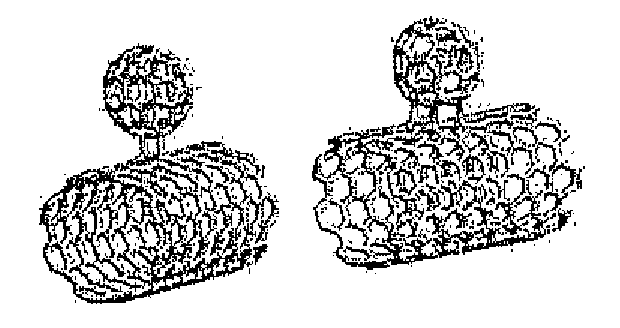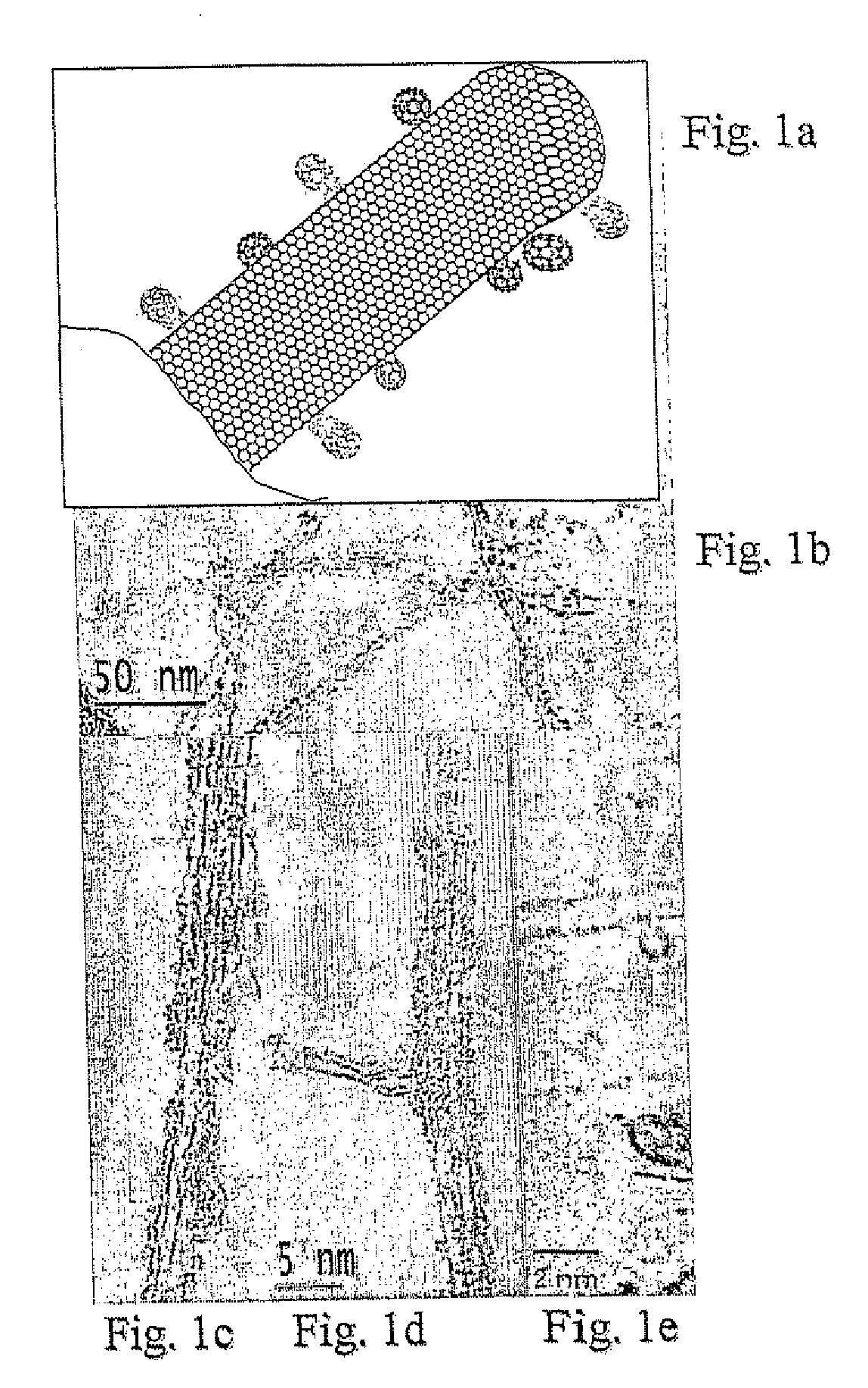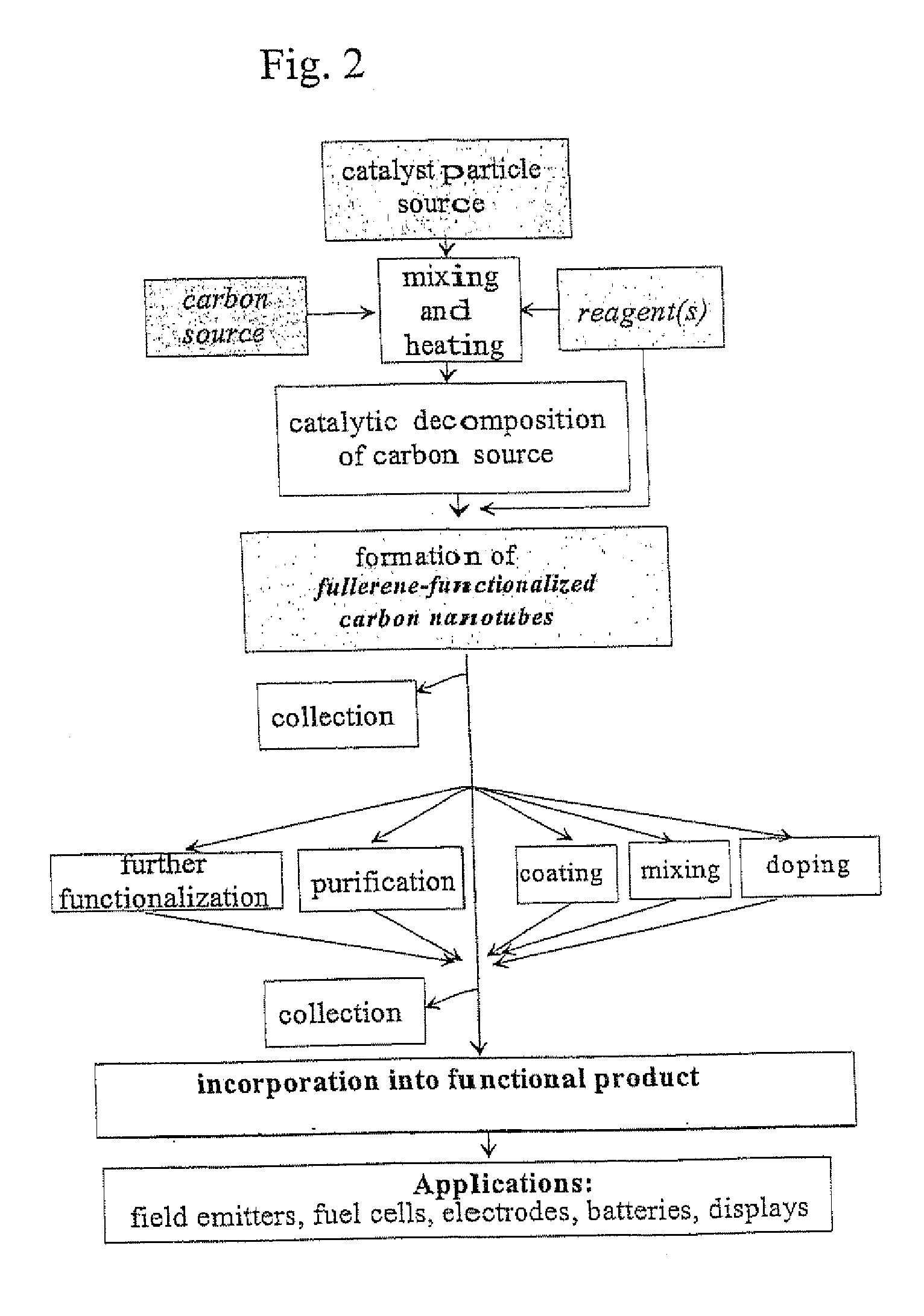Carbon nanotubes functionalized with fullerenes
a carbon nanotube and functional technology, applied in the field of carbon nanotubes functionalized with, can solve the problems of increasing the loss of product, adding additional impurities, and not being able to covalently attach fullerenes to the outer surface of carbon nanotubes, so as to improve the mechanical properties, enhance the cold electron field emission, and improve the electrical and/or optical properties of the material
- Summary
- Abstract
- Description
- Claims
- Application Information
AI Technical Summary
Benefits of technology
Problems solved by technology
Method used
Image
Examples
example 1
CBFFCNT Synthesis from Carbon Monoxide as Carbon Source Using Ferrocene as Catalyst Particle Source and Water Vapor and / or Carbon Dioxide as Reagent(s)
[0088]Carbon source: CO.
[0089]Catalyst particle source: ferrocene (partial vapor pressure in the reactor of 0.7 Pa).
[0090]Operating furnace temperatures: 800, 1000, and 1150° C.
[0091]Operating flow rates: CO inner flow (containing ferrocene vapor) of 300 ccm and CO outer flow of 100 ccm.
[0092]Reagent: water vapor at 150 and 270 ppm and / or carbon dioxide at 1500-12000 ppm.
[0093]This example was carried out in the embodiment of the present invention shown in FIG. 3(a). In this embodiment, catalyst particles were grown in situ via ferrocene vapor decomposition. The precursor was vaporized by passing room temperature CO from a gas cylinder (2) (with a flow rate of 300 ccm) through a cartridge (4) filled with the ferrocene powder. Subsequently, the flow containing ferrocene vapour was introduced into the high temperature zone of the cerami...
example 2
CBFFCNT Synthesis from a Plurality of Carbon Sources and Reagents and Using Hot Wire Generator as Catalyst Particle Source
[0096]Carbon source: CO, thiophene and octanol.
[0097]Catalyst particle source: hot wire generator.
[0098]Catalyst material: iron wire of 0.25 mm in diameter.
[0099]Operating flow rates: CO flow of 400 ccm through thiophene-octanol (0.5 / 99.5) solution and hydrogen / nitrogen (7 / 93) flow of 400 ccm through the HWG.
[0100]Reagent: H2, octanol and thiophene.
[0101]Operating furnace temperature: 1200° C.
[0102]This example illustrating the synthesis of CBFFCNTs was carried out in the embodiment of the present invention shown in FIG. 3(b). Catalyst particles were produced by vaporizing from a resistively heated iron wire and subsequent cooling in a H2 / N2 flow. Next the particles were introduced into the reactor. Octanol and thiophene vapor was used as both carbon sources and reagents and were introduced via a saturator (6). Partial pressures for the octanol and thiophene vapo...
example 3
CBFFCNT Synthesis from Carbon Monoxide as Carbon Source Using Hot Wire Generator as Catalyst Particle Source and Reagent Introduced or Formed on the Walls of the Reactor
[0103]Reactor tube: stainless steel with a composition of Fe 53, Ni 20, Cr 25, Mn 1.6, Si, C 0.05 weight %.
[0104]Carbon source: CO.
[0105]Catalyst particle source: hot wire generator.
[0106]Catalyst material: iron wire of 0.25 mm in diameter.
[0107]Operating furnace temperature: 928° C.
[0108]Operating flow rates: CO outer flow of 400 ccm and hydrogen / nitrogen (7 / 93) inner flow of 400 ccm.
[0109]Reagents: H2, CO2 and H2O formed on the reactor walls.
[0110]This example illustrating the synthesis of CBFFCNTs was carried out in the embodiment of the present invention shown in FIG. 3(c), wherein CO was used as both a carbon source and a reagent precursor. The reactor walls, composed of mostly iron, also served as a reagent precursor since CO2 and water vapor were formed on the walls of the reactor in the heating zone. FIG. 12 ...
PUM
| Property | Measurement | Unit |
|---|---|---|
| temperature | aaaaa | aaaaa |
| pressures | aaaaa | aaaaa |
| pressures | aaaaa | aaaaa |
Abstract
Description
Claims
Application Information
 Login to View More
Login to View More - R&D
- Intellectual Property
- Life Sciences
- Materials
- Tech Scout
- Unparalleled Data Quality
- Higher Quality Content
- 60% Fewer Hallucinations
Browse by: Latest US Patents, China's latest patents, Technical Efficacy Thesaurus, Application Domain, Technology Topic, Popular Technical Reports.
© 2025 PatSnap. All rights reserved.Legal|Privacy policy|Modern Slavery Act Transparency Statement|Sitemap|About US| Contact US: help@patsnap.com



